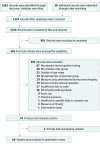Association of Cannabis With Cognitive Functioning in Adolescents and Young Adults: A Systematic Review and Meta-analysis
- PMID: 29710074
- PMCID: PMC6137521
- DOI: 10.1001/jamapsychiatry.2018.0335
Association of Cannabis With Cognitive Functioning in Adolescents and Young Adults: A Systematic Review and Meta-analysis
Abstract
Importance: Substantial shifts in perception and policy regarding cannabis have recently occurred, with use of cannabis increasing while its perceived harm decreases. One possible risk of increased cannabis use is poorer cognitive functioning, especially in youth.
Objective: To provide the first quantitative synthesis of the literature examining cannabis and cognitive functioning in adolescents and young adults (with a mean age of 26 years and younger).
Data sources: PubMed, PsycInfo, Academic Search Premier, Scopus, and bibliographies of relevant reviews were searched for peer-reviewed, English-language studies from the date the databases began through May 2017.
Study selection: Consensus criteria were used to determine study inclusion through abstract and manuscript review.
Data extraction and synthesis: This study followed Meta-analysis of Observational Studies in Epidemiology guidelines. Effect size estimates were calculated using multivariate mixed-effects models for cognitive functioning outcomes classified into 10 domains.
Main outcomes and measures: Results from neurocognitive tests administered in cross-sectional studies were primary outcomes, and we examined the influence of a priori explanatory variables on variability in effect size.
Results: Sixty-nine studies of 2152 cannabis users (mean [SD] age, 20.6 [2.8] years; 1472 [68.4%] male) and 6575 comparison participants with minimal cannabis exposure were included (mean [SD] age, 20.8 [3.4]; 3669 [55.8%] male). Results indicated a small overall effect size (presented as mean d) for reduced cognitive functioning associated with frequent or heavy cannabis use (d, -0.25; 95% CI, -0.32 to -0.17; P < .001). The magnitude of effect sizes did not vary by sample age or age at cannabis use onset. However, studies requiring an abstinence period longer than 72 hours (15 studies; n = 928) had an overall effect size (d, -0.08; 95% CI, -0.22 to 0.07) that was not significantly different from 0 and smaller than studies with less stringent abstinence criteria (54 studies; n = 7799; d, -0.30; 95% CI, -0.37 to -0.22; P = .01).
Conclusions and relevance: Associations between cannabis use and cognitive functioning in cross-sectional studies of adolescents and young adults are small and may be of questionable clinical importance for most individuals. Furthermore, abstinence of longer than 72 hours diminishes cognitive deficits associated with cannabis use. Although other outcomes (eg, psychosis) were not examined in the included studies, results indicate that previous studies of cannabis in youth may have overstated the magnitude and persistence of cognitive deficits associated with use. Reported deficits may reflect residual effects from acute use or withdrawal. Future studies should examine individual differences in susceptibility to cannabis-associated cognitive dysfunction.
Conflict of interest statement
Figures



References
-
- Substance Abuse and Mental Health Services Administration Results From the 2013 National Survey on Drug Use and Health: Summary of National Findings. Rockville, MD: Substance Abuse and Mental Health Services Administration; 2014.
-
- Johnston LD, O’Malley PM, Miech RA, Bachman JG, Schulenberg JE. Monitoring the Future National Survey Results on Drug Use, 1975-2016: Overview, Key Findings on Adolescent Drug Use. Ann Arbor: Institute for Social Research, The University of Michigan; 2017.
-
- Giedd JN, Blumenthal J, Jeffries NO, et al. . Brain development during childhood and adolescence: a longitudinal MRI study. Nat Neurosci. 1999;2(10):861-863. - PubMed
Publication types
MeSH terms
LinkOut - more resources
Full Text Sources
Other Literature Sources
Medical

